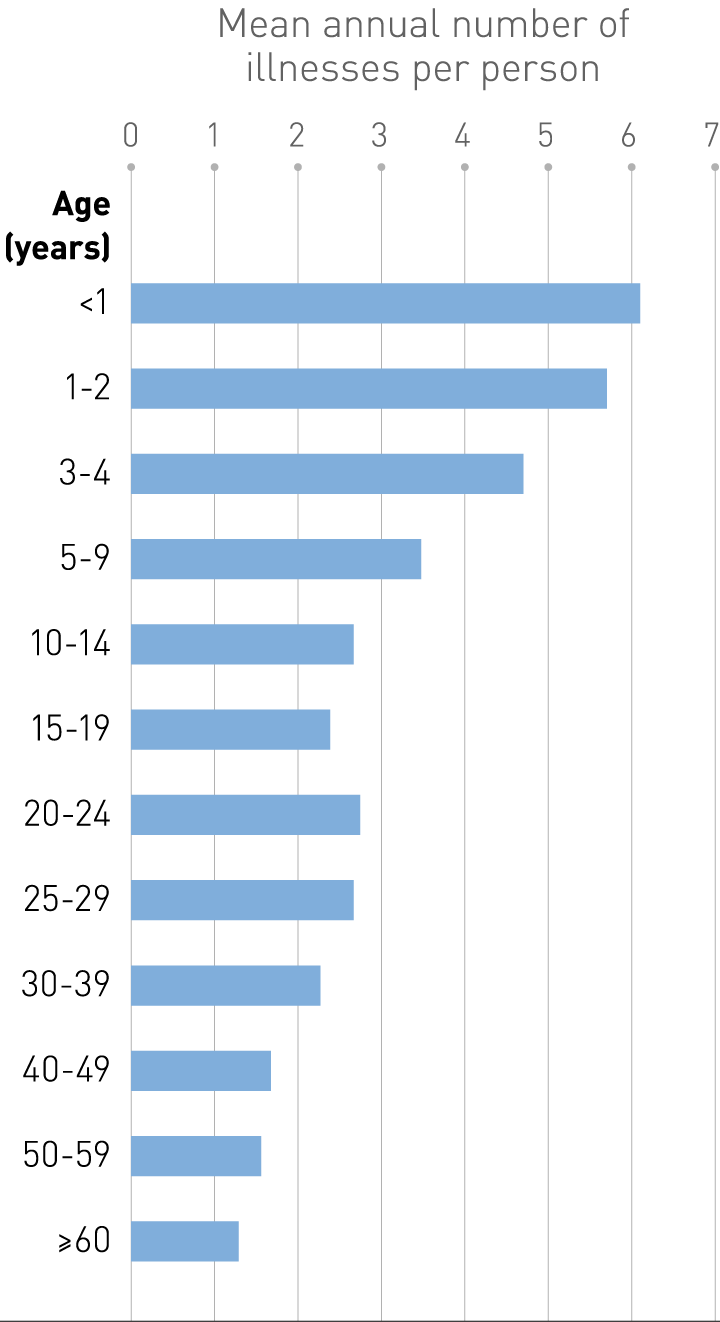Clinical Research & Literature — Respiratory
Common Cold
An upper respiratory trait infection, one of the most common infectious diseases of humankind.

Clinical Research & Literature — Respiratory
Common Cold
An upper respiratory trait infection, one of the most common infectious diseases of humankind.
The common cold, an upper respiratory trait infection, is one of the most common infectious diseases of humankind. At least 200 identified viruses can cause the common cold. Some of these viruses include rhinoviruses, coronaviruses, parainfluenza viruses, and such. Common symptoms to all these infections are nasal congestion, throat clearing, sneezing and cough.
The Common Cold¹
Despite the available sophisticated diagnostic methods, about 20-30% of colds remain without a proven viral cause.
The occurrence of the common cold shows clear seasonality. In northern hemisphere regions, the frequency of respiratory infections increases rapidly in the autumn and decreases again in spring. In tropical areas, most colds start during rainy season. When looking at age, the incidence of upper respiratory infections is inversely proportional to age. The youngest children have on average 6-8 colds per year, while adults have 2-4. Also, during the first years of life boys seem to have more respiratory infections than girls, while this difference is reversed later in life. Further analysis of the epidemiology of the common cold, its pathogenesis and clinical manifestations can be read in this article.

Viral causes of the common cold

Viral causes of the common cold

Mean annual incidence of respiratory illnesses per person per age group

Mean annual incidence of respiratory illnesses per person per age group
Prevalence of Human rhinovirus infection in young children with acute wheezing²
Recurrent wheezing is common and one of the leading causes of chronic illness in childhood. Viral infection affects wheezing and asthma in children and adults of all ages. Usually, wheezing illnesses are viral in origin, and children with more severe wheezing episodes are more likely to develop asthma later in their life. Human rhinoviruses (HRV) are the main pathogens responsible for the common cold, but also have a major impact on asthma pathogenesis. The aim of this study was to determine the prevalence of HRV as a cause of acute wheezing in Egyptian children after an acute respiratory illness. The study showed that HRV was the second common viral infection in children with wheezes. The prevalence was more common in winter with higher incidence of recurrence.
Cold temperature and low humidity are associated with increased occurrence of respiratory tract infections³
Seasonal variation in the outbreaks of viral infection is common. Peaks are mostly observed during the winter months. Clinical evidence supporting an association between cold weather and respiratory tract infection (RTI’s) is mainly based on increases of general practitioner consultations during lower temperatures. RTI’s also increase wintertime morbidity and even account for at least 20% of excess winter mortality. While examining the association of daily monitored environmental temperatures and humidity with the onset of respiratory infections in a northern population with a high infection rate, the following was observed: daily average temperature was significantly associated with common cold, occurring more often in cold temperatures. Furthermore, lower humidity was associated with an increased amount of URTIs.
Nasal obstruction in neonates and infants⁴
The nasal airway contributes to respiration and olfaction. The nose and sinuses condition air before it reaches the lower respiratory tract by providing almost 100% humidification. It also filters and traps foreign particles. The airway epithelium contributes to the host defence system. Any changes to this system can cause significant problems. This happens particularly in neonates who are obligate nasal breathers until they are at least two months old. The following consequences of nasal obstruction in infants can occur; respiratory distress or discomfort, altered sleep cycle, increased risk of obstructive apnoea, and feeding difficulties.
Nasal congestion in infants and children: a literature review on efficacy and safety of non-pharmacological treatments⁵
In infants and children, the most common cause of nasal obstruction and runny nose are infections, mainly of viral origins or allergies. Viral upper respiratory tract infections (URTI) are frequently seen in neonates and infants during nasal obstruction. Saline irrigation is believed to eliminate excess mucus and reduce congestion. However, the efficacy and safety of non-pharmacological options for the treatment of such nasal congestion in infants, such as hypertonic and isotonic solutions and other medical devices such as nasal aspirators, is less studied and documented. Nasal aspiration with a medical device, associated with an isotonic saline solution, during viral rhinitis, has been shown to lower risk of developing acute otitis media and rhinosinusitis, in comparison with a group treated with physiological saline solution alone.
The impact of nasal aspiration with an automatic device on upper and lower respiratory symptoms in wheezing children: a pilot case-control study⁶
The impact of proper aspiration of nasal secretions during upper respiratory infection in the frequency and severity of symptoms of lower airways has never been investigated. Infections of the upper and lower airways, as well as wheezing, are the first causes of children below 2 years to consult a doctor. This pilot study concludes that the use of automatic nasal aspirator in children with a history of recurrent wheeze was associated with an improved respiratory health during the cold season.
Main takeaways
Common Cold
The common cold is one of the most common infectious diseases.¹
On average young children have 6-8 colds per year, while adults have 2-4.¹
Respiratory Tract Infections (RTI’s) increase wintertime morbidity and account for at least 20% of excess winter mortality.³
Nasal obstruction in infants can cause respiratory distress, altered sleep cycle, increased risk of obstructive apnoea, and feeding difficulties.⁴
Viral upper respiratory tract infections are frequently seen in neonates and infants during nasal obstruction.⁵
Nasal aspiration with a medical device, associated with an isotonic saline solution during viral rhinitis, has been shown to lower risk of developing acute otitis media and rhinosinusitis, in comparison with a group treated with physiological saline solution alone.⁵
The use of an automatic nasal aspirator in children with a history of recurrent wheeze was associated with an improved respiratory health during the cold season.⁶



